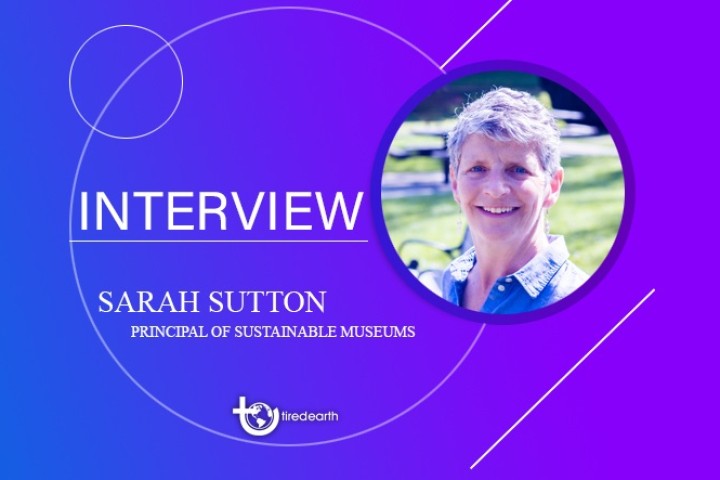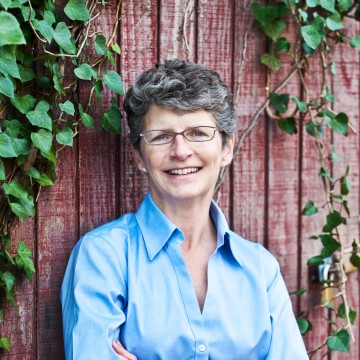Tired Earth: An Interview with Sarah Sutton, Principal of Sustainable Museums

This interview was conducted by Selva Ozelli
What was the idea/inspiration behind creating Sustainable Museums? Environment & Culture Partners (ECP), the nonprofit co-founded with Stephanie Shapiro, was born late last year and began operating officially on September 1st, 2021. Our mission is to accelerate environmental leadership in cultural institutions and the cultural sector.
Sustainable Museums was my small business of the last 25 years. For the last 16 years of that time I consulted with museums on environment and climate issues. The going has been slow. Most museums have been either reluctant or unable to pay for the work I do. They are willing to pay for an engineer to redesign their energy systems, a consultant to conduct a waste audit, but to work with an organization for high level planning and strategy, or to participate in coordinated action, just did not fit their approaches. Those audits and replacements are important, but they change only one institution and the change we need is much greater. We need large scale cooperative action, and more money to accomplish it. We believe that a nonprofit is more likely to be able to address the need for collective action and funding than a sole proprietor can. So when Stephanie, a long-time friend and colleague, approached me to form a partnership, we chose to create a nonprofit that could move our work and the sector's work to the next level.
Tell us about your organization's initiatives concerning getting museums involved in sustainability, climate change education, action, research and partnerships?
Our approach is collaboration; our priority is mitigation (carbon reduction). We also pursue public engagement through climate change education and action but the majority of work right now is on understanding and reducing the sector's greenhouse gas emissions.
Right now we are coordinating a National Leadership Grant project in partnership with the New England Museum Association, a two-year program that will develop energy sensitivity models for eight types of museum buildings and operations in the US (zoos and aquariums, historic houses, museums with art or history or science activities, children's museums, and public gardens). The project will provide a "this is where you look first" roadmap for energy use reduction in building types. It will also give us our best estimate yet of the carbon footprint of US museums. We'll use the approach developed during the project to reduce that footprint. Our role is to coordinate the work of the 150 partner institutions with the energy consultants, helping them share energy use data easily and then learn from it. We're not energy consultants, we're museum supporters who happen to know a bit about climate change, its causes and impacts.
This year The International Committee for Museums and Collections of Science and Technology (CIMUSET) which is a scientific committee of the International Council of Museums (ICOM) during its 48th #CIMUSET Annual Conference: "Museums & Environmental Concerns, New Insights" -7-11 November 2021, will address our planet's environmental concerns and how Science and Technology museums can approach and present this important issue via education and exhibitions. When did your organization get involved in climate change and what programs has it instituted?
Sustainable Museums, my previous company, began this work in 2005 when I was asked to write a grant to fund a sustainability plan for a college campus. When I was done learning how to create that plan and make a case for it, I knew museums had to be part of this work - for their own survival, their missions, and their service to their communities.
I'm delighted to see the focus of the CIMUSET program. Public engagement is critical for spreading awareness, building literacy, and driving public demand for more action. Science museums have a special role in explaining climate science, introducing systems thinking, and providing platforms for citizen science engagement. Every museum, however, can align its mission and responsibilities with climate change engagement and action. Every museum must prioritize climate action. There are no more excuses. I hope that science museums can partner with other museum types to blend climate science knowledge with their sister museums' broader audiences and more varied formats of public engagements. The entire field would benefit from these partnerships.
What partnerships does Sustainable Museums have? Does it collaborate with the UN, America's All In, Museums, zoos, gardens, aquariums and cultural heritage sites?
The Culture over Carbon project with the New England Museum Association is a partnership of course. And all the museum types you list here are part of that work.
ECP leads the cultural sector of America is All In, the largest coalition of non-state actors in climate work anywhere in the World. This is where we connect cultural institutions to the work and knowledge of so many other civil sectors: business, investors, faith, health, higher education, and local and tribal governments. Our hope is that as other alliances for climate action appear in countries around the world, that they too will have strong cultural sector participation. www.AmericaisAllIn.com
A great partnership has come out of America is All In. The Helen Frankenthaler Foundation wished to start a project funding clean energy generation and energy efficiency at visual arts institutions, but lacked the expertise in energy issues and the museum sector reach it needed to offer this $5M grant program. So the Foundation has partnered with ECP and Rocky Mountain Institute to manage the program. We gave away $5M this year to 79 US visual arts institutions, and plan to give away another $5M over the next two years. www.frankenthalerclimateinitiative.org
We're working with institutional partners on two other projects - a carbon footprinting tool for museums and museum exhibits, and a point-of-sale opportunity for the public to purchase carbon offsets for their museum memberships and visits.
And a project we're part of, Sustainability Tools in Cultural Heritage (STiCH) is partnering on an EU tender for a toolkit on sustainability in collections care as we speak.
How can people reach Sustainable Museums?
You can reach Environment & Culture Partners at www.ecprs.org and [email protected]
Anything else you might want to add.
I tell all my museum colleagues that inaction on climate is negligence. That's a pretty sobering statement. It's also true. AND we can turn that urgency into an asset. It reprioritizes all our work, and gives us permission to focus on actions that improve our institutional well-being by saving money and energy and time while creating safe and welcoming spaces. We must push away the old mindset of focusing on what the institution needs. We must instead focus on what the community needs and what are our best resources for supporting resolution of those needs - with the community, not individually. We are charitable, educational, community-oriented organizations. Helping our communities address our most significant challenges is what we are so perfectly suited to do. Is there any better mission or job than that?

